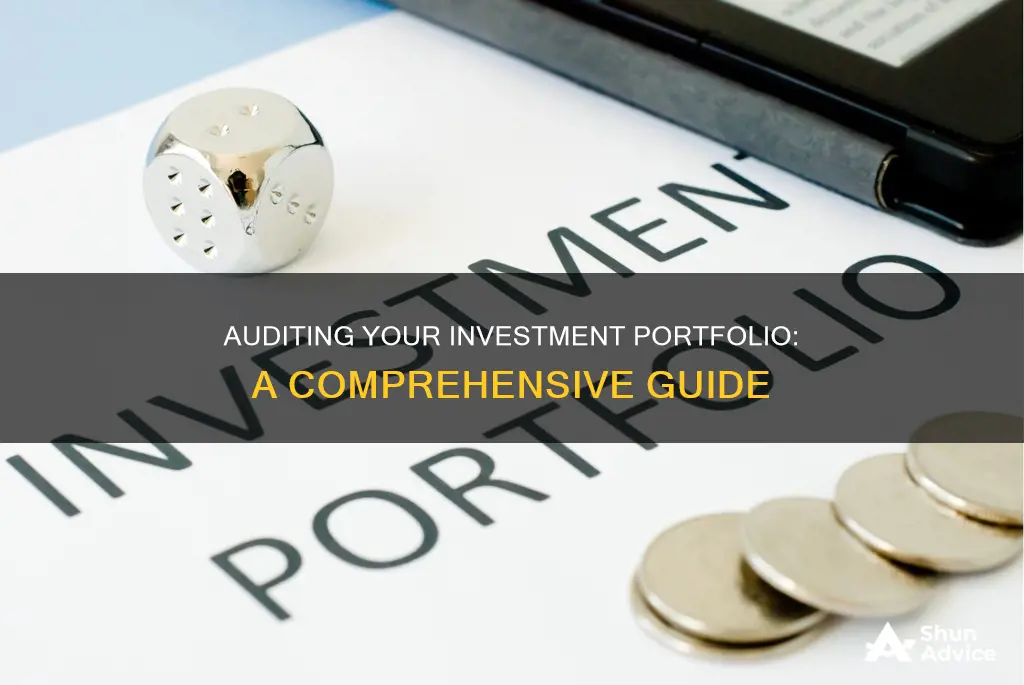
Auditing an investment portfolio is a complex process that requires a comprehensive understanding of the portfolio's composition and associated risks. The process involves confirming the existence and accuracy of investment balances, assessing the risk of material misstatement, and evaluating the effectiveness of internal controls. When performing an audit, it is crucial to consider the different types of investments, such as stocks, bonds, mutual funds, and ETFs, as they may require unique valuation methods and carry distinct risks. Auditors must also be vigilant for hidden costs, excessive fees, and other factors that may impact the overall returns of the portfolio. By conducting a thorough audit, investors can gain a clearer understanding of their investment costs and identify areas where they can improve their investment strategies and optimise their portfolio performance.
| Characteristics | Values |
|---|---|
| Confirm balances | Confirm the existence of investments and their accuracy |
| Audit values | Assess the value of unusual investments |
| Assess risk | Identify the directional risk of investments, e.g. overstatement |
| Identify common issues | Identify common control deficiencies, e.g. one person managing buying, selling, recording and reconciling |
| Assess complexity | Determine the complexity of the investments and adapt audit methodology |
| Assess fees | Identify internal expenses, fees and hidden costs |
| Assess completeness | Check all investments are reflected on the balance sheet |
| Categorise investments | Held-to-maturity, trading, available-for-sale |
| Assess accuracy | Check the accuracy of the value of investments and how it is determined |
| Assess consistency | Ensure consistency with GAAP |
| Assess ownership | Confirm ownership of investments |
| Assess management intent | Evaluate whether management intent conflicts with investment activities |
| Assess ability to hold | Evaluate the ability to hold a debt security to maturity |
| Assess impairment | Identify any factors that may indicate an other-than-temporary impairment condition |
What You'll Learn

Confirming existence, ownership, and completeness
Understanding the Importance of Asset Verification
Asset verification is essential for maintaining accurate and reliable asset records. It helps establish trust with stakeholders, mitigate risks, ensure compliance with regulations, facilitate decision-making, and prevent disputes. By confirming the existence and ownership of assets, individuals and organizations can make informed choices, enhance transparency, and safeguard their financial interests.
Essential Steps for Asset Verification
To confirm existence, ownership, and completeness, the following steps should be considered:
- Identify the types of assets and required documents: Recognize the different types of assets, such as real estate, financial assets, and personal assets, and determine the specific documents needed for each category. For instance, real estate assets may require deeds, titles, and mortgages, while financial assets may include bank statements and investment statements.
- Locate and organize documents: Gather and organize the required documents, which may be in physical or digital possession, or held by third parties such as banks or brokers. Use folders, labels, or spreadsheets to categorize them efficiently.
- Verify and update documents: Check the validity, accuracy, and completeness of the documents. Look for any discrepancies, errors, or missing information that could impact asset verification. Update documents to reflect any changes in assets, such as acquisitions or transfers.
- Prepare and submit documents: Format and submit the documents according to the requirements of the requesting entity, such as a lender or regulator. Keep a record of the submission and confirmation.
Verifying the Existence of Tangible Assets
Conducting a physical inspection of tangible assets is crucial to confirm their existence and ownership. This process involves:
- Creating a detailed asset inventory with descriptions, unique identifiers, locations, and relevant documentation.
- Adopting a systematic approach by organizing inspections by asset categories or locations.
- Documenting the inspection process by taking photographs and capturing the condition of assets.
- Implementing asset tagging and labeling to streamline the inspection process and easily track assets.
- Considering sample inspections for large or complex assets to save time and resources.
- Seeking external expertise from professional asset inspectors or auditors for specialized knowledge and an unbiased assessment.
Confirming Ownership through Legal Documentation
Legal documentation plays a vital role in confirming the existence and ownership of assets. This includes property deeds, vehicle titles, and share certificates. The verification process involves scrutinizing documents for tampering or inconsistencies, cross-referencing information with external sources, and seeking legal expertise for complex cases.
Analyzing Financial Statements for Asset Verification
Analyzing financial statements is essential for verifying the existence and ownership of assets, as well as their value and condition. This includes reviewing the balance sheet, income statement, cash flow statement, and statement of changes in equity. Obtaining financial statements and supporting documents, such as invoices, receipts, contracts, and deeds, is crucial for this process.
Seeking Professional Assistance
Engaging professionals, such as appraisers, auditors, and valuation experts, provides valuable insights and ensures accurate and reliable evaluations. They possess specialized knowledge in specific asset classes and conduct extensive market research to determine fair market value. Additionally, they adhere to professional standards and ethics, maintaining objectivity and providing impartial assessments.
Invest Your Savings: Safe Strategies for Beginners
You may want to see also

Assessing risk
Investment Walkthroughs
This involves performing a risk assessment by examining the potential for investments to be overstated or understated, whether intentionally or by mistake. It includes asking questions about the types of investments, the valuation methods, the involvement of specialists, the classification of investments, the competence of personnel, the timeliness and accuracy of reconciliations, the existence of investment restrictions, and the authority for opening or closing investment accounts.
Directional Risk
The directional risk for investments is typically their potential to be overstated. It is important to perform audit procedures to ensure that balances are properly stated and address any discrepancies.
Primary Risks
Some common primary risks associated with investments include:
- Theft of investments
- Intentional overstatement of investments to conceal theft
- Intentional omission of investment accounts from the general ledger
- Misstatements due to errors in investment reconciliations
- Improper valuation due to complex investments and insufficient accounting knowledge
- Misstatements due to improper cutoff
- Inaccurate or incomplete investment disclosures
Control Deficiencies
It is important to identify and address any control deficiencies that may exist. Common deficiencies include:
- Lack of segregation of duties, with a single person buying, selling, recording, and reconciling investments
- Inadequate knowledge or skill of the person overseeing investment accounting
- Untimely or improper investment reconciliations
- Insufficient assistance in valuing complex assets
Risk of Material Misstatement
This is a critical aspect of the audit process. In smaller audit engagements or when control risks are assessed as high, the inherent risk becomes the primary driver of the risk of material misstatement. When control risk is assessed as less than high, it is necessary to test the effectiveness of controls to support the lower-risk assessment.
Substantive Procedures
In response to higher-risk assessments, it is important to perform substantive procedures such as confirming investments, testing investment reconciliations, vetting investment disclosures, and using specialists to value complex instruments.
Work Papers
The audit work papers should include documentation related to investment-related internal controls, risk assessments, control deficiencies, investment audit programs, reconciliations, confirmations, valuations by specialists, and documentation of the specialist's credentials and objectivity.
Investment-led Savings: The Economy's Driving Force
You may want to see also

Understanding different investment types
Understanding the different types of investments is a key part of auditing an investment portfolio. The investment landscape is dynamic and ever-evolving, but those who understand the basic principles and different asset classes stand to gain significantly over time.
The first step is to learn to distinguish between different types of investments and their relative risk. The investment risk ladder identifies asset classes based on their riskiness, with cash being the most stable and alternative investments the most volatile.
A cash bank deposit is the simplest and most easily understandable investment asset. It guarantees investors will get their capital back, plus a known interest rate. However, interest rates on savings accounts rarely beat inflation. Certificates of deposit (CDs) are less liquid, but they usually offer higher interest rates, though the money is locked up for a fixed period.
Bonds are debt instruments representing a loan from an investor to a corporation or government agency. The borrower issues a fixed interest rate in exchange for the use of the capital, and bonds are often used to finance operations, purchases, or projects. Bond rates are influenced by interest rates, and they are heavily traded during periods of quantitative easing or when central banks raise interest rates.
Mutual funds are a type of investment where multiple investors pool their money to purchase securities. They are managed by portfolio managers who allocate the pooled investment into stocks, bonds, and other securities. Mutual funds often have minimum investments of $500 to $5,000, but even a small investment can provide exposure to a diverse range of stocks. These funds can be designed to mimic underlying indexes like the S&P 500 or Dow Jones Industrial Average, or they can be actively managed and updated by portfolio managers. Actively managed funds tend to have greater costs, such as yearly management fees, which can reduce investor returns. Mutual funds are valued at the end of the trading day, and all transactions are executed after the market closes.
Exchange-traded funds (ETFs) are similar to mutual funds but trade throughout the day on a stock exchange, mirroring the behaviour of stocks. Their value can change drastically during a trading day. ETFs can track underlying indexes or any basket of stocks chosen by the issuer, including emerging markets, commodities, individual business sectors, and more. Due to their ease of trading and broad coverage, they are very popular with investors.
Shares of stock let investors participate in a company's success through price increases and dividends. Shareholders have a claim on the company's assets in the event of liquidation but do not own the assets. Holders of common stock have voting rights, while preferred stockholders do not but receive preference for dividend payments.
Alternative investments include real estate, hedge funds, private equity funds, and commodities. Real estate can be acquired directly or through real estate investment trusts (REITs), which trade like stocks. Hedge funds invest in a spectrum of assets to deliver returns beyond market performance, but performance is not guaranteed, and they can be incredibly volatile. They are typically only available to wealthy investors and often require high initial investments of $1 million or more, along with net worth requirements. Private equity funds are similar to mutual and hedge funds but tend to focus on long-term investments of 10 years or more, often taking a controlling interest in an operating company. Commodities refer to tangible resources such as gold, silver, crude oil, and agricultural products. They can be accessed through commodity pools or specialised ETFs.
Other investment types include hybrid securities, which combine the characteristics of stocks and bonds, and call and put options, which are complex and require a higher-level risk tolerance.
National Savings and Investments: A Secure Financial Future
You may want to see also

Verifying value and accuracy
Understanding Recognised Amounts
Recognised amounts in financial statements are crucial as they represent the values attributed to assets, liabilities, revenues, and expenses. These amounts are determined by accounting principles and standards, such as Generally Accepted Accounting Principles (GAAP) or International Financial Reporting Standards (IFRS). Understanding these recognised amounts and ensuring their accuracy is essential for auditors and stakeholders alike.
Documentation Review
Auditors start by examining the company's financial statements, including the balance sheet, income statement, and statement of cash flows. They carefully review the footnotes and disclosures to grasp the accounting methods and assumptions used in determining recognised amounts. This provides insight into the company's financial health and performance.
Accounting Policies
Companies often have choices in accounting policies that can significantly impact recognised amounts. Auditors assess whether these policies are consistent with established accounting standards and if they have been consistently applied over time. Inconsistent or inappropriate accounting policies can distort the financial statements.
Valuation Methods
Recognised amounts depend on the chosen valuation methods. For example, inventory valuation can use the First-In, First-Out (FIFO) or Last-In, First-Out (LIFO) methods. Auditors evaluate the suitability of these methods and whether they accurately reflect the economic reality of the business. Inaccurate valuation methods can misrepresent the value of assets.
Estimates and Fair Value
Recognised amounts often involve estimates, especially for items like provisions for doubtful debts or fair value measurements. Auditors assess the reasonableness of these estimates by comparing them to historical data and current market conditions. Inaccurate estimates can lead to misstated financial statements.
Materiality
Auditors consider materiality when assessing recognised amounts. A material misstatement can significantly impact financial statements and affect stakeholders' decisions. Auditors use quantitative and qualitative factors to set materiality thresholds and identify misstatements that require correction.
Comparative Analysis
Auditors perform comparative analysis by comparing current financial data with previous periods and industry benchmarks. This helps identify anomalies or trends that require further investigation. Significant fluctuations or deviations from industry standards may indicate potential irregularities or issues with investment valuation.
Analytical Procedures
Analytical procedures include ratio analysis, trend analysis, and common-size financial statements. These techniques help identify potential issues in recognised amounts, such as discrepancies or unusual patterns. By applying these procedures, auditors can gain valuable insights into the financial health and integrity of the organisation.
Testing Transactions
Auditors select a sample of transactions to test the accuracy of recognised amounts. For example, they may test sales transactions to ensure revenues are recorded accurately and comply with revenue recognition criteria. This provides assurance that the recorded transactions accurately reflect the company's financial activities.
Substantive Testing
Substantive testing involves obtaining sufficient and appropriate audit evidence regarding recognised amounts. This may include confirming account balances with third parties, inspecting supporting documents, or recalculating figures. By performing substantive testing, auditors can validate the accuracy of the financial data and improve the reliability of the financial statements.
Internal Controls
Finally, auditors assess the effectiveness of the company's internal controls related to recognised amounts. Strong internal controls can reduce the risk of errors or fraud in financial reporting. By evaluating these controls, auditors can identify weaknesses and recommend improvements to enhance the integrity and transparency of financial reporting.
In summary, verifying value and accuracy in an investment portfolio involves a comprehensive and meticulous examination of financial data, documentation, accounting policies, and internal controls. By following these steps, auditors can provide assurance to stakeholders that the financial statements accurately represent the portfolio's financial position and performance.
Money Management: Spend, Save, and Invest Wisely
You may want to see also

Evaluating management intent
Review Relevant Documentation
Auditors should examine written records, such as investment strategies, investment activity records, instructions provided to portfolio managers, and minutes from meetings of the board of directors or investment committee. These documents can provide valuable insights into the management's stated intent and their decision-making process.
Analyse Investment Activities
By reviewing the investment activities, auditors can identify any inconsistencies or conflicts with the stated intent. This analysis may include evaluating the types of investments made, the timing of transactions, and any strategic shifts in the investment portfolio.
Assess Alignment with Overall Business Goals
It is important to consider how the investment activities support the broader goals and objectives of the company. Are the investments aligned with the company's strategic direction, risk management framework, and financial targets? Do they contribute to the creation of long-term value for shareholders, or are they focused on short-term gains?
Evaluate Management Competence and Skills
The competence and skills of the management team play a crucial role in executing the stated investment intent. Auditors should assess whether the management team possesses the necessary expertise, experience, and qualifications to make informed investment decisions. This includes evaluating their understanding of the market, investment products, and risk management strategies.
Consider Historical Performance
Historical performance can provide valuable insights into the management's ability to execute their stated investment intent successfully. Auditors should review the track record of the management team, including their investment returns, the impact of their decisions on the company's financial health, and their ability to navigate different market conditions.
Understand Compensation Structures
The compensation structure for the management team can influence their investment decisions. Auditors should evaluate whether the compensation package, including salaries, bonuses, and stock options, is aligned with the long-term interests of the company and its shareholders. Are there any potential conflicts of interest or incentives that could impact the management's investment strategies?
By carefully evaluating these factors, auditors can gain a deeper understanding of management intent and ensure that the investment portfolio is being managed effectively, in line with the stated objectives and the best interests of the company and its stakeholders.
Investing: A Smarter Option Than Saving for Your Future
You may want to see also
Frequently asked questions
Confirm the existence of your client's security investments. If they use a custodian, request confirmation of the types of securities and the number of shares held, as well as their fair market value. If your client maintains custody, physically examine the securities and check corporate meeting minutes to confirm purchase authorisation.
The three main categories are held-to-maturity, trading, and available-for-sale. Held-to-maturity securities are those that the client intends to hold long-term, such as bonds. Trading securities are bought with the intention of selling them in the short term for a profit. Available-for-sale is a catch-all category for investments that don't fall into the other two.
The value of an investment and how it is determined should be audited. For complex investments, you may need a specialist to determine their value.
Primary risks include theft, intentional overstatement to cover theft, intentional omission from financial records, misstatement due to errors or a lack of accounting knowledge, improper valuation, and incomplete or inaccurate disclosures.
Internal expenses, 12b-1 fees, excessive commissions, hidden mark-ups or mark-downs on bond trades, and unnecessary advisory fees can all add up. These can significantly impact portfolio returns, so it's important to uncover these potential hidden costs.







